-
[PR]
×
[PR]上記の広告は3ヶ月以上新規記事投稿のないブログに表示されています。新しい記事を書く事で広告が消えます。
-
Quectel RG255C-GL 5G RedCap Module Successfully Passes Global Certifications
Recently, Quectel’s 5G RedCap module RG255C-GL has successfully passed multiple international certifications for the global market, including GCF global certification, North American FCC, IC, PTCRB certifications, European CE certification, and Australian RCM certification.
This means the Quectel RG255C-GL RedCap module is now fully commercially available and meets the stringent requirements for RedCap network connectivity in markets such as Europe, North America, and Australia. With balanced technical performance, this product provides stable and reliable connectivity support for IoT terminals like CPEs, MiFis, routers, gateways, locators, and industrial PDAs.
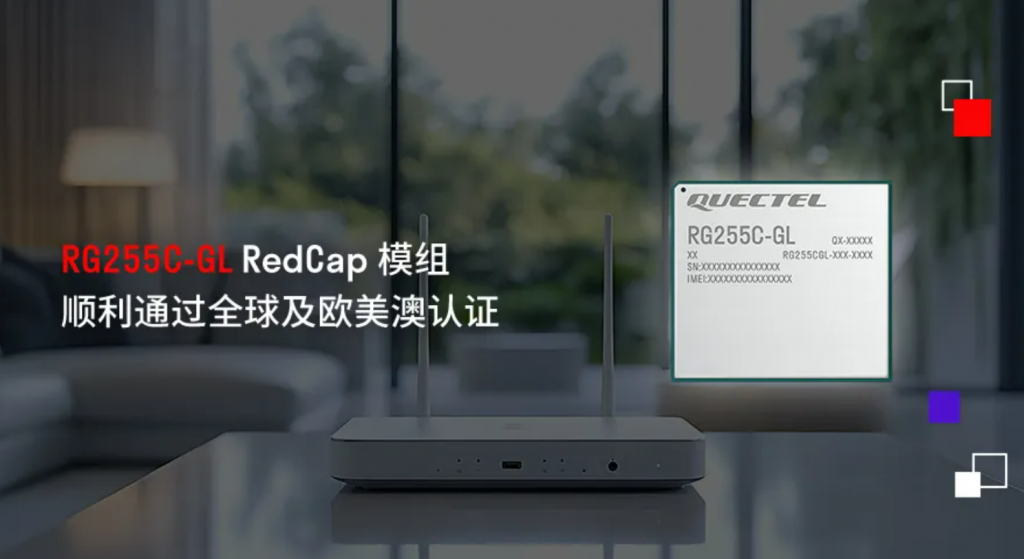
RedCap, a lightweight IoT technology derived from 5G NR, achieves cost optimization, size reduction, and lower power consumption by streamlining device capabilities and complexity. Meanwhile, RedCap retains important 5G native features, such as low latency, high reliability, and support for functions like 5G slicing and 5G LAN, making it highly suitable for the digital transformation needs of vertical industries.
Powerful Core, Achieving All-Around Excellence
The Quectel RG255C-GL module is based on the Qualcomm Snapdragon® X35 platform, designed for the global market, and widely compatible with major operators. It complies with the 3GPP R17 standard, supports 5G Sub-6 standalone (SA) mode and LTE Cat 4 networks, and is compatible with Rel-15 (SA) and Rel-16 (SA) networks, meeting the seamless integration and flexible deployment needs of terminal devices. The module also supports low-latency communication and key 5G features such as 5G LAN, uRLLC, and network slicing.

The RG255C-GL achieves a downlink speed of up to 223 Mbps and a peak uplink speed of 123 Mbps, suitable for entry-level FWA applications, video transmission, and mid-to-high-speed IoT requirements.
Additionally, the Quectel RG255C-GL supports the OpenWrt operating system, providing router customers with a wide range of flexible development options. This module also integrates Qualcomm® IZat™ positioning technology, supporting GPS, GLONASS, BDS, Galileo, and NavIC positioning technologies for faster, more precise, and reliable enhanced positioning services.

Compact Design, Demonstrating Exceptional Strength
Not only is the 5G Module powerful in performance, but it also features a sleek and compact design. It uses a compact LGA package, measuring only 32.0 mm × 29.0 mm × 2.4 mm, consistent in size with Quectel’s classic LTE Cat 4 module EG2x series, significantly simplifying the upgrade process for 4G devices, effectively shortening development cycles and reducing costs.
Moreover, the RG255C-GL integrates a rich set of interfaces, including USB 2.0, PCIe 2.0, PCM, UART, SGMII, and SPI, supporting various drivers and software functionalities, expanding its wide-ranging applications in the RedCap field.
In addition, this Quectel 5G module can be paired with various antennas from Quectel, allowing terminal customers to choose compatible antennas based on actual needs, thus reducing costs and accelerating product time-to-market.
PR -
Quectel's 5G-A RG650V Module Passes GCF/PTCRB Certification
Recently, Quectel, a leading global IoT solution provider, announced that its new 5G-A series module RG650V has become the first product based on Qualcomm’s Snapdragon X72 platform to successfully pass GCF/PTCRB certification.
The passing of these two certifications indicates that the Quectel RG650V meets the relevant regulations and standards for regions such as North America, achieving a secure and stable compatibility status with major operators in those regions, providing users with efficient and reliable 5G communication services. Notably, the RG650V has also passed the US FCC certification.

Consistency certification is a key step in bringing IoT devices to market. PTCRB certification focuses on device compatibility and performance on North American operator networks, while GCF is an international product consistency certification. Together, they provide dual assurance for compliant sales of wireless communication devices in key global markets. The RG650V, as the first module based on the Snapdragon X72 platform to pass both certifications, further demonstrates the leading edge of Quectel 5G modules and the company’s overall strength.
Developed on the world’s first 5G Advanced-ready modem and RF system—the Qualcomm Snapdragon X72—the RG650V employs 3GPP Rel-17 technology, supporting 5G NSA and SA modes, as well as Option 3x, 3a, 3, and Option 2 network architectures. It also supports extended 8Rx frequency bands and DL 4 × 4 MIMO technology to enhance 5G network coverage, transmission efficiency, and user experience. Additionally, the series is backward compatible with 4G/3G and supports the latest Wi-Fi 7 technology, introducing up to 4K QAM modulation and 2.4/5/6 GHz Wi-Fi, ensuring stable operation even in areas lacking 5G deployment.

For high-precision positioning applications, the RG650V series incorporates Qualcomm’s advanced IZat™ positioning technology (Gen 9VT) and an optional multi-constellation GNSS receiver, supporting GPS, GLONASS, BDS, Galileo, and QZSS positioning technologies. This enables faster, more accurate, and reliable positioning while simplifying product design and allowing for real-time adjustments based on terminal needs.
To expand the RG650V series’ application possibilities, the module features a range of industrial-standard interfaces, including USB 2.0/3.0/3.1, PCIe 3.0, PCM, and UART. It also comes with the OpenWrt operating system, offering broad and flexible development options for router customers. The series includes RG650V-EU and RG650V-NA versions to meet different regional requirements.
In recent years, the deep integration of 5G with AR/VR, ultra-high-definition video, big data, cloud computing, and the metaverse has driven innovation in 5G applications, creating new business models and experiences. At the same time, new industries present new network connection demands, making 5G-A a timely solution. The new 5G-A module RG650V series from Quectel not only stands out in terms of timeliness and leadership but also excels in performance, supporting the comprehensive upgrade of the communications industry chain and driving rapid digitalization across various sectors.
-
Quectel's High-End 5G Smart Module SG560D-NA First to Receive PTCRB Certification
Recently, Quectel announced that its high-end 5G Smart module SG560D-NA, based on the Qualcomm QCM6490 platform, has successfully received PTCRB certification. Prior to this, the module also obtained certifications from the US FCC and Canada’s IC, indicating that it fully meets the standards and regulations for North America. This ensures efficient and stable operation of related smart devices in the region, aiding customers in rapidly expanding into the North American market.

High-End 5G Performance Leader
The Quectel SG560D-NA, developed on the Qualcomm QCM6490 platform, features a high-performance octa-core 64-bit processor and an integrated Qualcomm Adreno™ 643 GPU (high-performance graphics engine), with a combined computing power of up to 14 TOPS. It offers efficient edge computing capabilities and rich multimedia features. Thanks to the dedicated NPU of the Qualcomm QCM6490 platform, the module achieves an optimal balance between performance and power consumption.
As an intelligent module product integrating 5G and edge computing capabilities, the SG560D-NA also boasts excellent wireless performance. It complies with the 3GPP R15 standard, supports both 5G NSA and SA modes, and is backward compatible with 4G/3G networks, providing comprehensive coverage of various network types. It supports 5G & LTE multiple-input multiple-output (MIMO) technology, delivering high-speed, stable, and ubiquitous cellular connectivity to end devices.
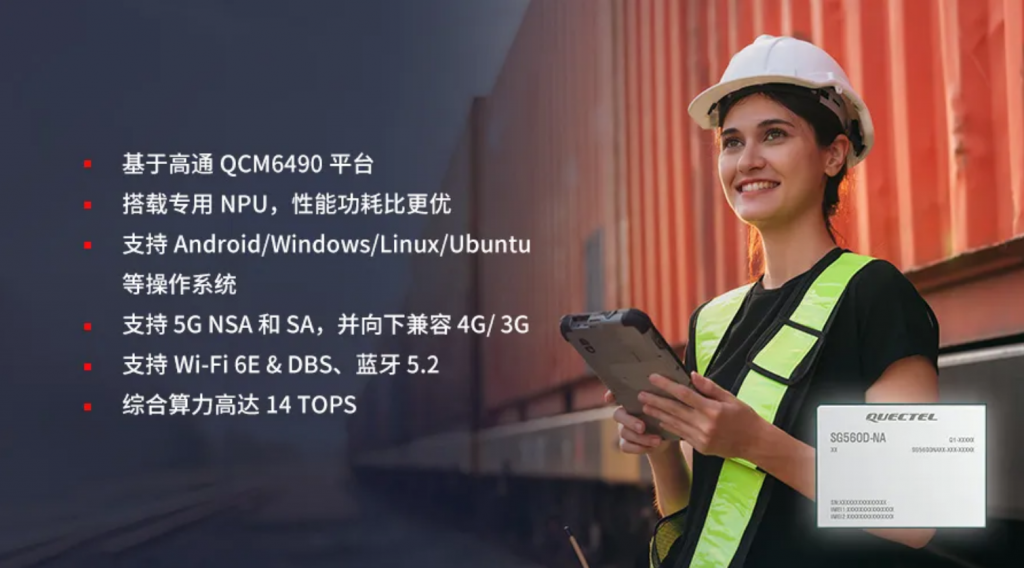
Moreover, the SG560D-NA supports Wi-Fi 6E & DBS, IEEE 802.11a/b/g/n/ac/ax, Wi-Fi 2 × 2 MU-MIMO, and Bluetooth 5.2 technology, further diversifying wireless connection options and significantly enhancing data transfer efficiency and reliability.
Additionally, the module integrates a multi-constellation GNSS receiver, supporting GPS, GLONASS, BDS, NavIC, Galileo, QZSS, and SBAS positioning systems, and supports dual-frequency positioning, effectively meeting the positioning needs of end devices.
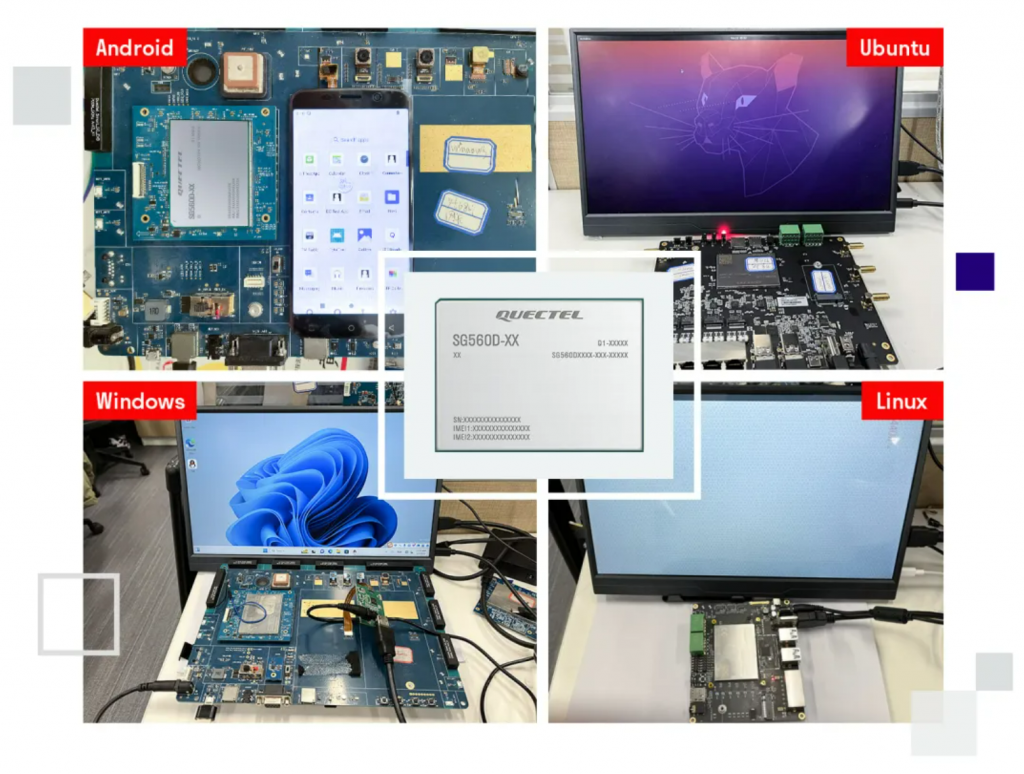
Smart and Flexible, Widely Applicable
The SG560D series runs on Android 13 and can be upgraded to Android 14/15 in the future. It also supports Windows, Linux, Ubuntu, and other operating systems, providing a broad range of options for various edge intelligent applications through its “one module, four systems” approach. This flexibility caters to the diverse needs of different industries and application scenarios.
The Quectel 5G Smart module features robust multimedia capabilities, with its built-in Adreno™ 643 GPU and 12 TOPS NPU power, facilitating quick and high-quality graphics rendering. Coupled with 4K H.265/H.264 video encoding and decoding capabilities, it delivers a smoother experience for multimedia-intensive scenarios.
Additionally, the SG560D-NA offers a range of functional interfaces such as LCM, camera, touchscreen, PCIe, UART, USB, I2C, and I2S, greatly expanding its application scope in the smart IoT field. It can be used in various domains including smart cash registers, intelligent robots, edge computing terminals, vending machines, facial payment terminals, smart gateways, CPE, MiFi, MID, PND, POS, routers, digital billboards, industrial PDAs, and smart security.

Furthermore, to accelerate the deployment of intelligent applications, Quectel provides a series of matching antenna products to help customers simplify terminal design and shorten product time-to-market.
In addition to the completed PTCRB, FCC, and IC certifications, the SG560D-NA is also undergoing certification with AT&T, Verizon, and T-Mobile. Moving forward, the module will continue to leverage its advantages in connectivity, edge computing, multimedia performance, and multi-system support to contribute further to intelligent development across more regions and industries.
Here now the Quectel QSM560DR 5G Smart Board based on Quectel SG560D module for industrial application is available here: https://www.4gltemall.com/quectel-qsm560dr-5g-smart-control-board.html .
-
SIMCom's Comprehensive Modules Unveiled at IOTE 2024
From August 28-30, the 22nd International Internet of Things Exhibition (IOTE 2024) grandly opened at the Shenzhen International Convention and Exhibition Center. SIMCom showcased a range of products, including 5G, smart, LTE-A, 4G, LPWA, and GNSS modules, along with application terminals. The exhibit richly demonstrated SIMCom’s solutions and application cases in various scenarios such as industrial IoT, smart cities, smart energy, smart homes, smart healthcare, vehicle networking, and smart agriculture.
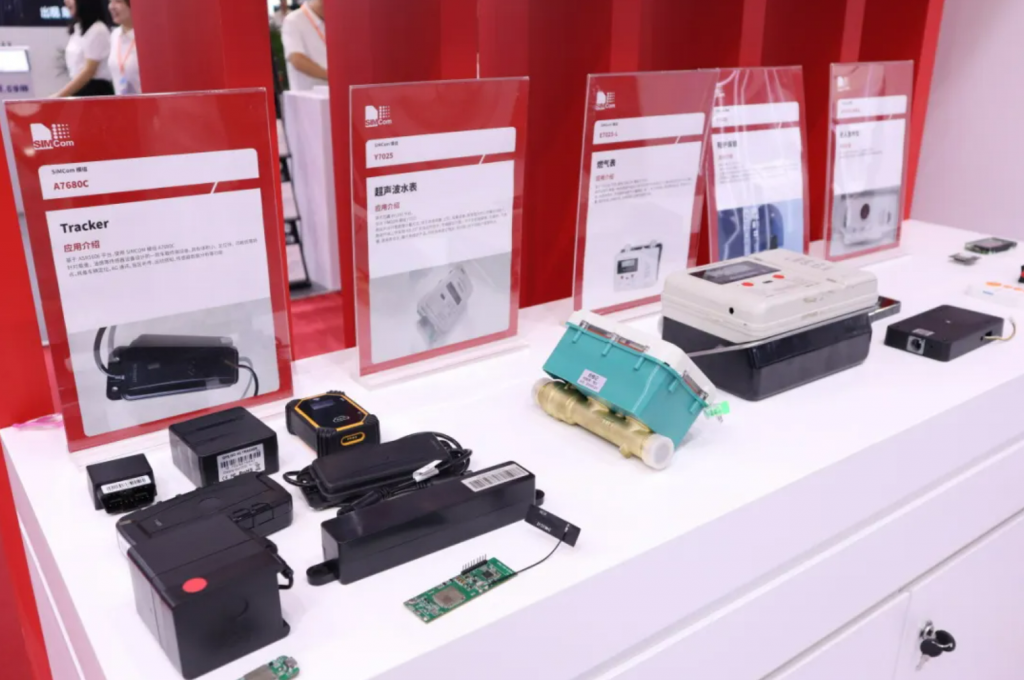
IOTE Gold Award Honors, Leading 5G Innovation
During the exhibition, the results of the IOTE Gold Award annual selection were officially announced. SIMCom’s 5G-A module SIM8390 won the “IOTE Gold Award” for innovative products. This accolade further highlights SIMCom’s achievements in the 5G domain, accelerating the empowerment of “high-speed” scenario needs and promoting digital transformation across industries with the help of 5G.
The SIMCOM SIM8390 supports Sub-6GHz and mmWave frequency bands. It offers a downlink speed of up to 10Gbps and an uplink speed of 3.7Gbps in the mmWave band, and in the Sub-6GHz band, it supports downlink speeds of 8Gbps and uplink speeds of 1Gbps, providing “10G downlink and 1G uplink” data transmission capabilities.
5G RedCap Shines at the Exhibition
As one of the cornerstones of 5G-A, 5G RedCap also shone brightly at the exhibition. SIMCom presented the SIM8230 series of 5G RedCap modules, available in LGA+LCC and M.2 packaging forms. These modules are equipped with Qualcomm’s X35 5G modem and RF system, offering peak download speeds of up to 220Mbps and uplink speeds of up to 100Mbps, meeting high-speed transmission requirements. They support VoNR and VoLTE, and integrate dual-frequency GNSS L1+L5 for precise positioning, making them suitable for high-speed scenarios such as FWA, smart wearables, and low-altitude economy.
In addition to 5G RedCap, SIMCom also showcased several popular 5G module products, including the SIM8202, R8200C, SIM8260, and the 5G/LTE+C-V2X module SIM8800. These modules are applicable to CPE, MiFi, ODU, IDU, Box, and other terminals, providing high-speed connectivity for enterprises, homes, and industrial scenarios. With various packaging forms and models covering different regions, these modules offer flexible product choices to help customers quickly enter target markets.
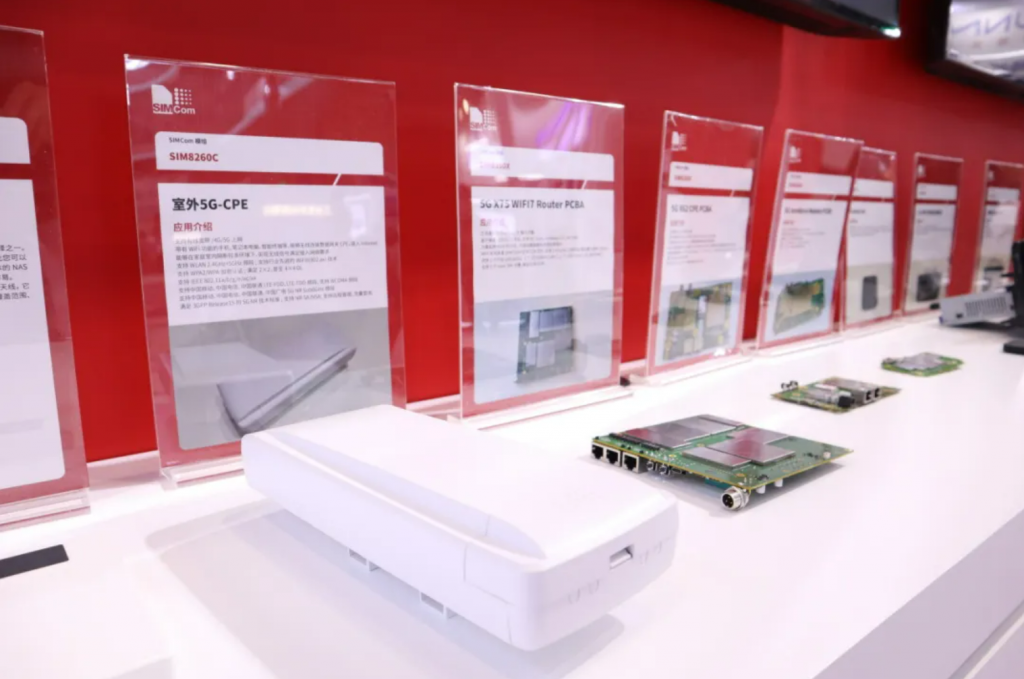
AI Capabilities on Display, Accelerating Smart Connectivity
In the AI era, computing power is the new productive force. At the exhibition, SIMCom showcased several intelligent modules with integrated AI algorithms, including SIM8918, SIM8906, SIM8905, SIM8971, SIM8973, SIM8970, SIM8950, SIM9650L, and SIM9650L-W. These modules cover different levels of computing power, frequency bands, regions, packaging forms, and sizes. They not only support efficient data transmission and processing but also include graphic processors for real-time analysis of massive graphics and video data, providing robust support for intelligent transformation across various industries.
Two high-performance intelligent modules, SIM9650L and SIM9650L-W, drew significant attention from visitors. With a combined computing power of up to 14 Tops, they support Wi-Fi 6E and Bluetooth 5.2 connections, and integrate SLAM algorithms, making them ideal for VR, intelligent robotics, low-altitude economy, and other scenarios requiring high-quality image and video input and the processing of large amounts of data and tasks.
LTE-A Ultra-Speed Experience, 4G Smart Connectivity
Despite the rise of 5G, LTE-A still maintains a significant market presence due to its compatibility and cost advantages. SIMCom’s LTE Cat.6 module SIM7906 and LTE Cat.12 module SIM7912 series achieve a balance between performance, speed, and cost, meeting the needs of various LTE-A application scenarios.
Additionally, the LTE Cat.1 module SIM7670G, suitable for remote information processing, metering, monitoring devices, industrial routers, and remote diagnostics, as well as the LTE Cat.4 automotive-grade modules SIM7800, SIM7805, and SIM7600 series for vehicle networking scenarios, were also featured. These modules cover frequency band requirements in Asia, Europe, South America, and North America, providing customers with more options and supporting the rapid development of vehicle networking and industrial IoT.
LPWA Green Engine, GNSS for the Future
Facing dual challenges of energy and environment, the application of low-power devices is crucial. SIMCom’s LPWA series modules, with their low power consumption and wide coverage features, contribute to the digital development of smart energy and water services.
The exhibition featured not only modules such as SIM7070G, SIM7070G-HP-S, SIM7080, Y7080E, SIM7022, SIM7000G, SIM7090G, and R7022 but also intelligent gas meters and ultrasonic water meters equipped with E7025-L and Y7025. These contribute to achieving green, low-carbon, and sustainable development in the energy sector.
Furthermore, SIMCom’s entire range of low-power, compact GNSS modules was also displayed, covering standard and high-precision needs and compatible with mainstream market sizes. These modules are suitable for applications such as autonomous driving, container monitoring, and smart agriculture. Among them, the SIM66D (-R) stands out as an indispensable new star for high-precision positioning applications due to its ultra-low power consumption, centimeter-level positioning, multi-system support, and compact size.
-
Fibocom FM350-GL 5G Wireless Module Review
Fibocom FM350-GL is a cutting-edge 5G wireless module designed for reliable connectivity in various industrial and commercial applications. Offering advanced features and robust performance, this module supports global 5G, 4G LTE, and 3G networks, ensuring seamless connectivity across different regions.

Key Features:
- 5G Connectivity: The FM350-GL supports both standalone (SA) and non-standalone (NSA) 5G modes, providing ultra-fast data speeds and low latency, which are crucial for applications like IoT, smart cities, and industrial automation.
- Global Coverage: It is designed to operate globally, supporting multiple frequency bands for 5G (Sub-6 GHz and mmWave), 4G LTE, and 3G networks. This versatility ensures compatibility with diverse network infrastructures worldwide.
- Reliability and Security: Built-in advanced security features such as secure boot, secure storage, and HTTPS provide robust protection for data transmission and storage, ensuring the integrity and confidentiality of sensitive information.
- IoT Optimized: With its compact form factor and low power consumption, the FM350-GL is ideal for IoT applications requiring reliable, always-on connectivity without draining battery life.
- High-Speed Data Transfer: It supports peak download speeds up to 5.0 Gbps and upload speeds up to 1.0 Gbps over 5G networks, facilitating rapid data transfer and real-time communication.
- Extended Temperature Range: The module operates efficiently across a wide temperature range (-40°C to +85°C), making it suitable for deployment in challenging environments such as industrial automation and outdoor IoT applications.
- Ease of Integration: Designed for easy integration into various devices and systems, the FM350-GL supports multiple interfaces including PCIe, USB 3.1, and I2C, offering flexibility for different connectivity needs.
- Future-Ready: With support for 5G technology, the module ensures that devices equipped with FM350-GL are future-proofed, ready to harness the full potential of emerging 5G networks.

Applications:
The Fibocom FM350-GL is well-suited for a wide range of applications including:
- IoT Devices: Smart meters, connected appliances, and asset tracking.
- Industrial Automation: Remote monitoring, predictive maintenance, and control systems.
- Smart Cities: Traffic management, public safety, and environmental monitoring.
- Telemedicine: Remote patient monitoring and healthcare IoT solutions.
- Enterprise Solutions: Video conferencing, cloud computing, and edge computing applications.
In summary, the Fibocom FM350-GL stands out as a versatile 5G module offering global connectivity, robust security, and high-speed data transfer capabilities. The Fibocom 5G module addresses the connectivity needs of diverse industries and applications, empowering businesses to leverage the benefits of next-generation wireless technology.

